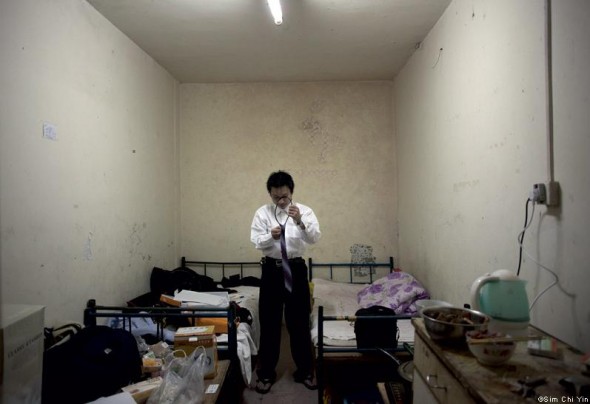August 10, 2012
By Simon Rabinovitch
Sim Chi Yin’s photographs explore beneath the streets of the city, where China’s low-income workers squash into tiny living spaces
The man looking after the tiny one-room apartments in the basement of the Beijing high rise was nervous. “The outside world doesn’t need to know about this. It will make China look like a poor, backward country. People shouldn’t know that our capital city has these underground rooms.”
For Beijing, a city obsessed with presenting a sleek image, the basement dwellings are embarrassing. Municipal officials want to close them. But it’s not easy. For tens of thousands of workers streaming into the capital in pursuit of a better life, a room without a view is all they can afford to rent. Local newspapers describe them as the “rat tribe”.
“When I came to Beijing, I didn’t expect a big apartment, but at least I thought I’d be above ground,” said Zhou Changqin, 25. A computer technician from Guizhou province, he has been living three stories beneath New Peace City, a large residential complex, for the past six months. “When there’s a big rain, it can rise up from the floor.”
The underworld is well concealed. Off a side street, a service entrance to New Peace City leads down a flight of stairs to a warren of narrow corridors and bedsits. Overhead, there are clanking water pipes and exposed electrical wires. The manager of the basement has affixed signs warning about the fire hazard and has installed a series of security cameras that monitor anyone passing through.
“It’s not comfortable living here. It’s dank and noisy,” says Zhang Hao, 26, an electrician from Henan province. Zhang lives with his wife in a room just big enough for a double bed, a small desk and an electric cooking plate. He has plastered his walls with beer ads and posters of bodybuilders with glistening muscles. “I was looking for decorations and these were lying around my office,” he says.
Although he shares much in common with his neighbours – most are young migrants who have come to Beijing for work – Zhang says there is no sense of community. “We might greet each other, but we never really interact.”
The municipal government encouraged the development of the underground apartments a decade ago as a solution to the problem of how to accommodate low-income workers. Air-raid shelters and the basements of new high rises were contracted out to entrepreneurs who renovated and divided them into rooms for rent. City officials now say they want to shut basements that do not meet legal safety standards. At least two residents died from electrocution during floods late last month, according to local media.
China has avoided having the slums that plague the developing world because of policies that deter permanent settlement in cities. But the underground world shows the limits of China’s street-level success. More than any other journalist, Sim Chi Yin shines a light on what lies beneath. The Singaporean photographer says she wants to capture the hope, not just the frustrations, of the basement dwellers. “I wanted to correct this misperception that they are dirty and worthless. They are spunky and aspire to do better.” Sim recounts the words of one woman she photographed: “The people upstairs were just born into better circumstances. We dress the same. We have the same hairstyles. The only difference is they can see the sun and we can’t.”
For more photos, click here.
Source: FT Magazine


Leave a Reply